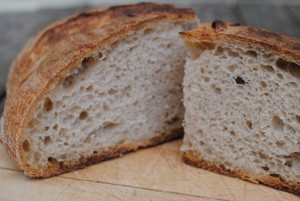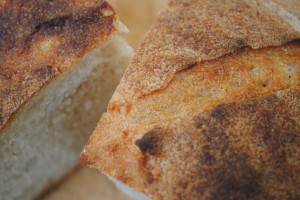A new oven
I’ve been cursed for the last decade with a decrepit electric oven that is pretty poor at everything, but is particularly dismal for baking. In order to overcome this, I normally use a large steel stockpot to cover my bread whilst it bakes, as I’ve mentioned in an earlier post. It works, but it isn’t a very elegant solution. In my very first post I talked about the now-discontinued Cuisinart Stone Oven, which seemed to offer the right combination of qualities for baking bread. I recently found one secondhand and, since I can’t afford a new oven-cooker, I decided to buy it.
The oven comes with top and bottom elements, and the walls are clad with firebrick panels that, along with a baking stone, absorb and store heat. This is ideal for bread, which needs a massive dose of heat in the first 5-10 minutes of baking in order to rise as much as possible before the crust forms and prevents further expansion. Most ovens rely solely on the heat source (electrical element or gas flame) to provide heat. When you put food into the oven, this heat flows into the food more quickly than the heat source can replace it. This isn’t a problem for most food you would cook in an oven, but it’s serious problem for bread. Materials that store heat – like brick, ceramic and stone – overcome the problem because, although they take longer to heat up, the stored energy forms a more or less plentiful supply that keeps flowing into the dough even when the heat source itself is struggling to keep up.
To test it out I made a cob loaf using a sourdough starter that I have recently revived from a frozen sample. The oven reached 260°c within half an hour – a Ferrari to my old oven’s Morris Minor. I gave the loaf ten minutes at that temperature, then turned it down to 200°c. Within another ten minutes, though, the crust was beginning to blacken.
The oven reached 260°c within half an hour – a Ferrari to my old oven’s Morris Minor. I gave the loaf ten minutes at that temperature, then turned it down to 200°c. Within another ten minutes, though, the crust was beginning to blacken. It turns out that the big flaw in the design of the Cuisinart oven is that the top heating elements, as well as the bottom ones, operate on the ‘bake’ setting and cannot be switched or adjusted independently. This means that the fierce radiant heat from above causes the crust to form too quickly, preventing maximum oven-spring – the same problem I get with my old oven-cooker (although for slightly different reasons).
It turns out that the big flaw in the design of the Cuisinart oven is that the top heating elements, as well as the bottom ones, operate on the ‘bake’ setting and cannot be switched or adjusted independently. This means that the fierce radiant heat from above causes the crust to form too quickly, preventing maximum oven-spring – the same problem I get with my old oven-cooker (although for slightly different reasons).
The loaf wasn’t bad, but it could have been a lot better. After removing the back of the oven to inspect its workings, it occurred to me that I might be able to to disconnect the top elements from the power supply. I wouldn’t dream of doing this normally, but the design of this little oven is quite simple, so it wasn’t a major undertaking. But would it work? There was only one way to find out…
